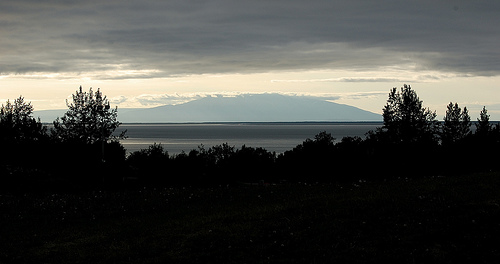Noah Garrison, Staff Attorney, Santa Monica
The Susitna River in Alaska charges icy, blue, sediment-laden snowmelt through a spectacular wilderness of tundra and boreal forest for 313 miles from its headwaters in the Alaska Range to the Gulf of Alaska. It drains an area larger than the states of Massachusetts or New Jersey and is one of the few remaining American rivers that travels freely from its glacial source to the ocean. A vibrant haven of aquatic diversity, it is home to five species of salmon, including one of Alaska’s largest runs of Chinook salmon, and more than 15 fish species overall, supporting thriving commercial and sport fishing communities. The upper river provides habitat for caribou, moose, bear, wolves, and eagles.
It is a terrible place to put the second highest dam in North America.
20,237-foot high Denali and the peaks of the Alaska Range rise over the Susitna River
The State of Alaska is pressing the Federal Energy Regulatory Commission to license a 735-foot high dam and hydroelectric plant on the Susitna (at a projected cost of $5.2 billion), which would drastically alter the river’s physical characteristics and create a 42-mile long, up to 5-mile wide reservoir that would flood approximately 25,000 acres of pristine wilderness, an area larger than the island of Manhattan. A myriad of secondary construction projects—access roads, transmission lines, and even a runway big enough to land commercial airliners—would further degrade the local environment. All of this is being proposed at a time when, as the New York Times reported earlier this year, “large dams are being taken down, not put up.” More than 430 dams have been removed across the U.S. since 1999 alone, and with good reason: dams kill rivers.
The Susitna River upstream from the proposed dam site—much of this wilderness would be flooded by an up to 5-mile wide reservoir.
One of the most destructive impacts of the dam will be to its salmon. Chinook, Coho, and other salmon start their lives in the Susitna or the countless tributaries that feed it. They migrate the sometimes hundreds of miles needed to reach open ocean as smolts or young salmon, then ultimately return to their birthplace, surging back upstream to spawn as adults. But dams change flow patterns—operation of the dam would increase the river’s flow by more than eight times its natural volume during winter months, washing away gravel and other small pebbles used by salmon to build protective nests for their eggs. The dam would also block the passage of salmon as they migrate up and downstream. An intrepid Chinook salmon was spotted in the Susitna this summer more than 300 miles upstream from the river’s outlet at the Cook Inlet, only a few miles from its source at the Susitna Glacier.
But this trip would be impossible with a 735-foot high wall of concrete blocking the way.
The changes in flow, sediment patterns, temperature, and too many other characteristics of the Susitna River this dam would cause could destroy entire ecosystems, taking with them resources that people depend on. The annual run of salmon on the Elwha River downstream of Washington’s Olympic National Park numbered around 400,000 before construction of a dam in 1913. After construction, the run dwindled to roughly 3,000. Thankfully, the Elwha dam was removed last year, and Chinook salmon were spotted upstream in the park for the first time in a century; we’ve learned from our mistakes. But while the rest of the country looks for ways to restore rivers and their fisheries, Alaska is driving ahead with its effort to raise a dam on the Susitna. This effort should be stopped. Dams kill rivers, and this dam is a bad idea.
Photo credits: Noah Garrison
Related articles











